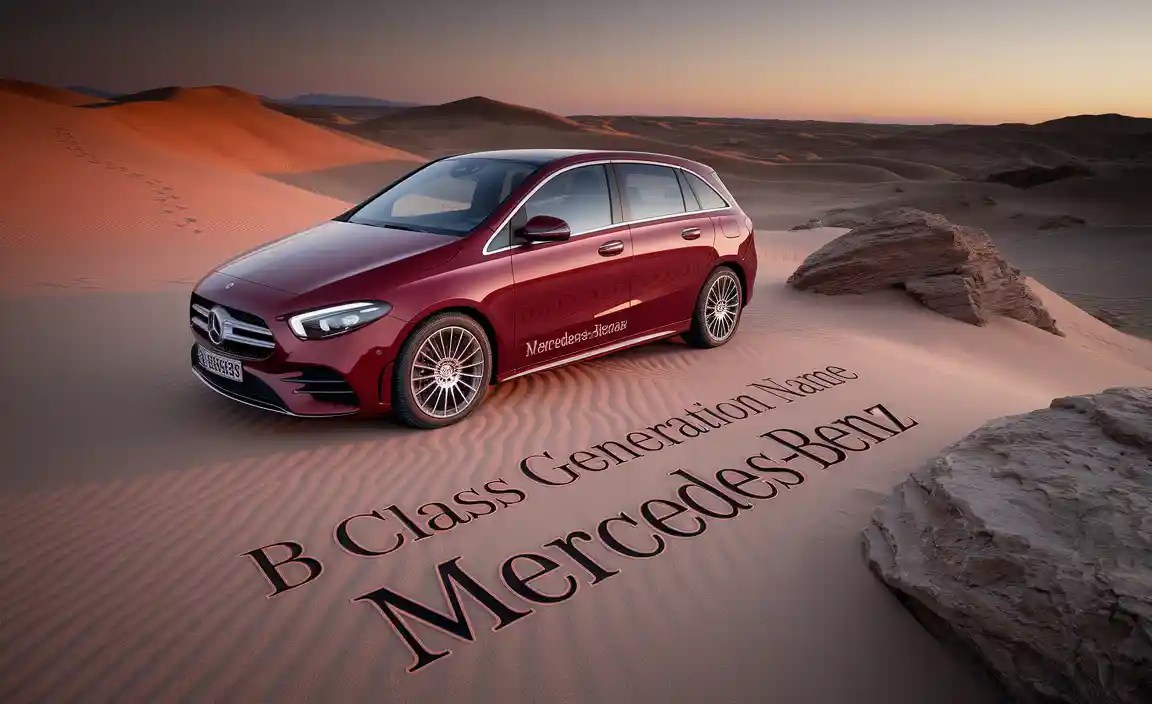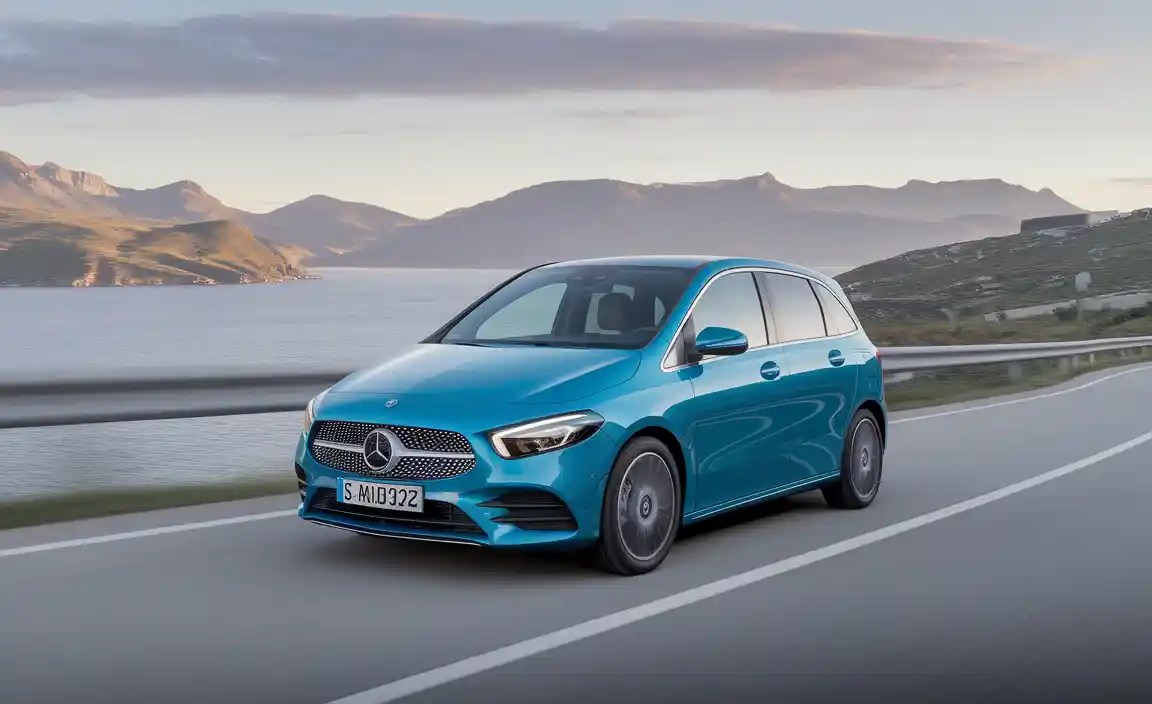B Class Generation Name: Ultimate Luxury
The official “B Class Generation Name” refers to the first generation of Mercedes-Benz’s compact MPV, internally designated as the W245 when it debuted in 2005. This generation established the B-Class as a practical yet premium hatchback offering.

Navigating the world of Mercedes-Benz model designations can sometimes feel like deciphering a secret code. For those curious about the “B Class Generation Name” and what truly defines that specific era of luxury, you’ve landed in the right place. Understanding these generational names helps us connect with the vehicle’s history and its evolution. This guide will break down the B-Class’s first generation, explaining what made it unique and why its designation is important. We’ll explore its design, technology, and what it represented for Mercedes-Benz at the time. Get ready to discover the story behind the first B-Class generation and its place in the Mercedes-Benz legacy.
Unpacking the “B Class Generation Name”: The W245 Era
When Mercedes-Benz introduced its innovative compact MPV, they assigned it an internal code: the W245. This designation is the true “B Class Generation Name” for the first generation of this model. Launched in 2005, the W245 marked a significant step for Mercedes-Benz, venturing into a segment that prioritized versatility, space, and intelligent design, all while retaining the brand’s signature luxury and build quality. It wasn’t just another car; it was a statement about how compact vehicles could embody premium characteristics.
The W245 was engineered with a unique sandwich-floor concept. This design pushed the engine, transmission, and other heavy components low and forward beneath the passenger cabin. This clever packaging served several key purposes: it created a remarkably spacious interior for its exterior dimensions, offered enhanced safety in a frontal impact by allowing components to slide underneath the cabin, and contributed to a higher seating position, enhancing visibility for the driver.
Key Characteristics of the W245 B-Class
The first generation of the B-Class, identified by the W245 code, brought a distinct set of features and philosophies to the compact premium segment. Its success and the subsequent generations owe much to the foundation laid here.

- Sandwich Floor Design: As mentioned, this was a cornerstone of the W245’s engineering. It allowed for exceptional interior volume and safety.
- Versatility and Space: Offering generous passenger and cargo space, the W245 appealed to families and individuals needing practicality without compromising on refinement. The rear seats were often adjustable, enhancing its adaptability.
- Premium Interior: Even in its compact form, the W245 featured the high-quality materials, fit, and finish expected of a Mercedes-Benz.
- Advanced Safety: Mercedes-Benz integrated its renowned safety systems, including multiple airbags and electronic stability programs (ESP), setting a high bar for safety in its class.
- Comfortable Ride: The W245 was tuned for comfort, making it an excellent choice for longer journeys or daily commuting where a smooth ride was a priority.
The Driving Experience: What it Felt Like
Driving a W245 B-Class was an experience defined by a sense of command and composure. The elevated seating position provided a commanding view of the road, making maneuvering in urban environments surprisingly easy. This, combined with the car’s refined suspension, delivered a ride that was both comfortable and stable, absorbing road imperfections with a grace typical of larger Mercedes-Benz models.

While not designed as a sports car, the W245 offered competent performance from its range of engines. Power delivery was smooth and predictable, suited for everyday driving needs. The steering felt precise, and while body lean was present in spirited cornering due to its higher stance and comfort-oriented tuning, it never felt uncontrolled. The cabin remained remarkably quiet, even at higher speeds, contributing to the overall sense of luxury and refinement.
Engine and Powertrain Options
The W245 generation was offered with a variety of petrol and diesel engines, catering to different driving needs and market preferences. These engines were known for their efficiency and reliability, further underscoring the premium nature of the B-Class.
| Engine Type | Displacement | Power Output (approx.) | Torque (approx.) |
|---|---|---|---|
| Petrol (e.g., B 170, B 200) | 1.7L – 2.0L | 115 – 136 hp | 155 – 180 Nm |
| Diesel (e.g., B 180 CDI, B 200 CDI) | 2.0L | 109 – 140 hp | 250 – 300 Nm |
Transmission options typically included a 5-speed or 6-speed manual gearbox, with the popular AUTOTRONIC continuously variable transmission (CVT) available on many models, offering seamless acceleration.
Technology and Innovation in the First Generation
Even by today’s standards, the W245 B-Class incorporated thoughtful technology designed to enhance the ownership experience. Mercedes-Benz focused on user-friendly systems that provided tangible benefits.
- COMAND System: For many models, an optional COMAND (Cockpit Management and Navigation) system was available, offering integrated navigation, radio, and entertainment functions.
- Advanced Climate Control: Features like THERMATIC automatic climate control were standard or available, ensuring a consistently comfortable cabin environment.
- Parking Assistance: Early forms of parking sensors (PARKTRONIC) were offered, helping drivers navigate tight spaces with greater confidence.
- Connectivity: Provisions for Bluetooth connectivity were beginning to appear, allowing for hands-free calling and basic phone integration.
These features, while perhaps not as advanced as the latest iterations, represented a significant level of technology for a compact vehicle in the mid-2000s, reinforcing the B-Class’s premium positioning.
Safety Innovations That Defined W245
Safety was, and remains, paramount for Mercedes-Benz. The W245 generation was equipped with a suite of passive and active safety features:
- Front and Side Airbags: Standard front airbags, plus side airbags for front occupants, provided crucial protection.
- Window Airbags: Many W245 models also came equipped with curtain airbags stretching across the side windows for enhanced occupant protection in side impacts.
- Anti-lock Braking System (ABS): Standard on all models, ABS prevents wheel lock-up during hard braking, allowing the driver to maintain steering control.
- Electronic Stability Program (ESP): A vital safety system that detects and reduces skids by braking individual wheels and reducing engine power when necessary.
- Pre-tensioners and Load Limiters: Seatbelts featured pre-tensioners to immediately tighten in a collision and load limiters to control the force exerted on the occupant.
For more on automotive safety standards and history, the National Highway Traffic Safety Administration (NHTSA) offers extensive resources on vehicle safety.
Evolution to the Second Generation (W246)
The success of the W245 paved the way for its successor, the second generation, internally known as the W246. Launched in 2011, the W246 built upon the strengths of its predecessor while incorporating significant advancements in styling, technology, and efficiency. While the “B Class Generation Name” remains “B-Class,” the internal codenames distinguish them.
The W246 adopted a more dynamic and streamlined exterior design, moving away from the somewhat utilitarian lines of the W245. The interior also saw a significant upgrade with a more modern dashboard layout, improved infotainment systems, and higher-quality materials. Mechanically, the W246 introduced more fuel-efficient engines and advanced driver-assistance systems, aligning the B-Class more closely with the technological offerings of its larger S-Class and C-Class siblings.
Key Differences: W245 vs. W246
Understanding the transition from the first to the second generation highlights Mercedes-Benz’s continuous innovation:
| Feature | W245 (First Generation) | W246 (Second Generation) |
|---|---|---|
| Debut Year | 2005 | 2011 |
| Exterior Styling | Functional, tall MPV profile | More dynamic, sleeker lines, coupé-like profile |
| Interior Design | Spacious, practical, robust | Modern, premium, larger infotainment screen |
| Infotainment | Early COMAND, simpler interfaces | Advanced COMAND, higher resolution screens, better connectivity |
| Safety Systems | Strong safety suite for its era | Enhanced systems, including Collision Prevention Assist, Attention Assist |
| Efficiency | Good for its class | Improved fuel economy, lower emissions |
| Powertrain | Range of petrol and diesel engines | Further refined petrol and diesel engines, introduction of electric drive (Electric Drive) |
What “B Class Generation Name” Means for Today’s Buyer

Choosing a Pre-Owned W245 B-Class
For those looking at the used car market, a W245 B-Class can be an excellent value proposition. They offer Mercedes-Benz luxury, safety, and practicality at a more accessible price point. When inspecting a pre-owned W245, pay attention to the general condition, service history, and any known wear and tear.
Key areas to inspect:
- Service Records: Look for consistent maintenance, especially oil changes and any major service intervals related to belt replacements or fluid changes.
- Suspension and Brakes: As with any vehicle, check for any unusual noises over bumps or during braking.
- Interior Wear: Check seats, carpets, and interior trim for excessive wear or damage, particularly given its potential use as a family car.
- Electronics: Test all MBUX systems, climate control, windows, and other electrical components to ensure they are functioning correctly.
Reliable information on common issues and maintenance for specific models can often be found on enthusiast forums or manufacturer-backed owner sites. Resources like Mercedes-Benz USA owner section can provide manuals and service information.
Benefits of the W245 Generation:
- Exceptional interior space for its footprint.
- High safety standards.
- Comfortable and refined ride quality.
- Premium Mercedes-Benz build and feel at a used car price.
- Relatively straightforward mechanics for maintenance.
Potential Considerations for W245:
- Styling may be perceived as less modern compared to later generations or other segments.
- Infotainment systems are dated by current standards.
- Fuel efficiency, while good for its time, may not match the latest powertrains.
The “B Class Generation Name” of W245, therefore, signifies a pioneering step in the premium compact MPV segment, delivering a blend of luxury, practicality, and safety that was ahead of its time.
Conclusion
Understanding the “B Class Generation Name,” specifically the W245 era, provides a deeper appreciation for this unique Mercedes-Benz model. It wasn’t just a compact car; it was a thoughtfully engineered vehicle that prioritized space, safety, and premium comfort in an innovative package.
The first generation established a blueprint for versatility and intelligent design, proving that a smaller vehicle could embody the core values of luxury and refinement expected from the three-pointed star. Whether you’re considering purchasing a pre-owned W245 or simply curious about Mercedes-Benz’s diverse lineup, recognizing this generation’s contributions highlights the brand’s consistent drive to innovate and cater to evolving consumer needs.
Frequently Asked Questions
What does the internal code “W245” mean for the B-Class?
The “W245” is the internal factory designation for the first generation of the Mercedes-Benz B-Class, produced from 2005 to 2011. It signifies the specific platform and generation of that particular model.
Was the B-Class always considered a luxury vehicle?
Yes, from its inception as the W245, the B-Class was positioned by Mercedes-Benz as a premium compact vehicle. It offered luxury materials, advanced safety features, and the brand’s renowned build quality, distinguishing it from non-premium competitors.
What was the main innovation of the W245 B-Class?
The most significant innovation was its unique “sandwich floor” design. This allowed for a very spacious interior relative to its exterior size and improved safety by placing heavy components beneath the cabin.
Are the engines in the W245 B-Class fuel-efficient?
The W245 offered a range of petrol and diesel engines that were considered efficient for their class and time of production. However, compared to the latest generation of vehicles, their fuel economy might be less competitive.
Is the W245 B-Class a reliable car for long-term ownership?
With proper and regular maintenance, the W245 B-Class can be a reliable vehicle. Adhering to Mercedes-Benz’s recommended service schedule is crucial for ensuring longevity and optimal performance.
Where can I find official specifications for older Mercedes-Benz models?
Official specifications and owner’s manuals for older Mercedes-Benz models like the W245 can often be found on the manufacturer’s official website, such as the Mercedes-Benz owner portal in your region. Automotive archives and enthusiast clubs are also good resources.
How does the W245 compare to the W246 generation?
The W246 (second generation) brought significant updates in styling, technology, and efficiency. It featured a more modern exterior, an improved interior with a larger infotainment screen, and advanced driver-assistance systems, while retaining the core B-Class practicality.






